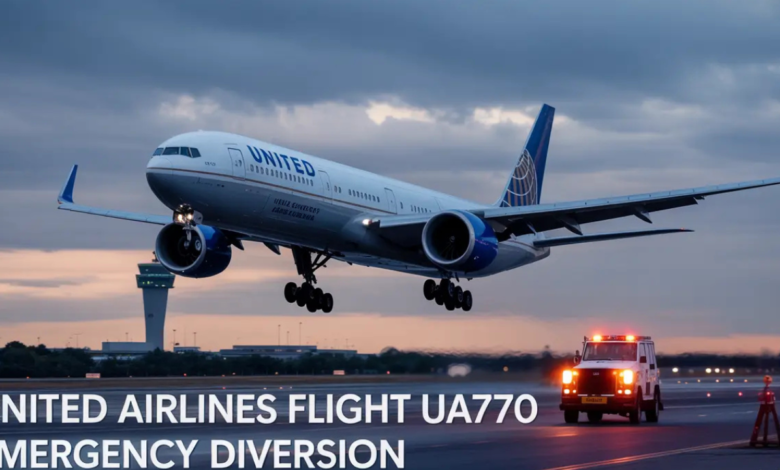
Introduction
Air travel has become a routine experience for many, but unexpected events can still occur. When something interrupts a scheduled journey, it reminds us that safety always comes first. One such situation involves the United Airlines flight UA770 emergency diversion, which brought attention to how airlines handle mid-air issues. This article explores everything related to that event, examining what it means for travelers, aviation protocols, and flight safety.
What Is an Emergency Diversion?
Before diving into the United Airlines flight UA770 emergency diversion, let’s first understand the concept of an emergency diversion. This term refers to a flight being rerouted from its planned destination to another airport, usually due to technical, medical, or weather-related issues. Emergency diversions are rare, but when they happen, quick decisions must be made by pilots and ground staff.
Choosing Between a United Airlines Flight UA770 Emergency Diversion or Continuing the Journey
Choosing between a United Airlines flight UA770 emergency diversion and continuing on schedule is never a light decision. The flight crew must weigh risks, weather forecasts, fuel levels, and passenger well-being. In the case of flight UA770, the decision to divert was guided by standard aviation practices focused on preserving safety above all.
Why Emergency Diversions Happen
The United Airlines flight UA770 emergency diversion wasn’t the first of its kind, and it won’t be the last. Diversions can occur due to:
- Sudden health emergencies involving passengers or crew
- Mechanical faults discovered during the flight
- Unpredictable weather ahead
- Security-related concerns
In the case of the United Airlines flight UA770 emergency diversion, early indications pointed to an onboard issue requiring immediate attention.
How the Crew Handles In-Flight Emergencies
Flight crews train regularly for emergencies. During the United Airlines flight UA770 emergency diversion, flight attendants and pilots followed strict checklists and protocols. These procedures ensure that all passengers are kept informed and that the situation is handled calmly and efficiently.
Passenger Experience During an Emergency Diversion
For those on board, the United Airlines flight UA770 emergency diversion was an unplanned detour. But according to travelers, the crew’s calm demeanor and transparent communication helped reduce fear. Announcements were made explaining the decision, and passengers were updated throughout the diversion process.

The Importance of Airport Readiness
The success of the United Airlines flight UA770 emergency diversion wasn’t only about the aircraft or its crew—it also depended on the airport where the diversion occurred. Airports that receive diverted flights must be prepared to respond quickly with emergency services, ground handling, and support.
What Happens After an Emergency Diversion
After the United Airlines flight UA770 emergency diversion, passengers were guided off the plane and arrangements were made for rebooking or ground transportation. These efforts are part of United Airlines’ standard response, aiming to ensure customer comfort even when plans go off track.
Flight Safety Is the Top Priority
The United Airlines flight UA770 emergency diversion reminds everyone of aviation’s core focus: safety. No airline wants to alter its route without good reason. But when safety is potentially compromised, acting quickly to reroute is the right call.
Impact on Airline Operations
While the United Airlines flight UA770 emergency diversion caused a temporary disruption, airline staff quickly worked behind the scenes to minimize broader impact. Operations teams coordinated aircraft repositioning, updated schedules, and ensured that affected passengers were taken care of.
How Technology Aids Emergency Decisions
Modern aircraft like the one involved in the United Airlines flight UA770 emergency diversion are equipped with systems that detect abnormalities and guide pilots. From real-time communication with air traffic control to onboard diagnostics, these tools enable fast and informed decision-making.
Public Response and Media Attention
Whenever an event like the United Airlines flight UA770 emergency diversion occurs, it garners public interest. Social media posts, news articles, and discussions often emerge. However, most passengers praised how the situation was handled, appreciating the crew’s professionalism.
What Passengers Should Know About Diversions
Travelers may wonder what their rights are in the case of a United Airlines flight UA770 emergency diversion. Airlines generally offer compensation or assistance based on the circumstances. However, in emergencies, safety takes precedence, and airlines are not liable for decisions made to protect lives.
Crew Training for Diversions and Emergencies
The United Airlines flight UA770 emergency diversion demonstrated how crucial proper training is. Pilots and flight attendants undergo repeated simulations of emergency scenarios to prepare them for real-world situations.
Comparing Past Diversions to United Airlines Flight UA770 Emergency Diversion
Compared to other incidents, the United Airlines flight UA770 emergency diversion was managed efficiently. There were no reports of panic, and all systems worked as expected. It stands as a textbook case of how diversions should be handled.
The Role of Air Traffic Control
During the United Airlines flight UA770 emergency diversion, air traffic controllers played a critical role. They cleared airspace, coordinated landing priorities, and ensured that the aircraft reached the diversion airport without delay.
Customer Service After Diversion Events
Following the United Airlines flight UA770 emergency diversion, passengers were met by customer service agents who assisted with logistics, hotel arrangements if needed, and follow-up travel plans. These efforts helped restore confidence after a stressful experience.
The Value of Clear Communication
One of the strongest elements in managing the United Airlines flight UA770 emergency diversion was clear communication. From cockpit updates to ground staff explanations, passengers felt included in the process rather than left in the dark.

Conclusion
The United Airlines flight UA770 emergency diversion stands as a strong example of how preparation, communication, and training come together to protect passengers. While unexpected, the event was handled with professionalism and care. For travelers, it reinforces a key truth—air safety is built on decisions made calmly under pressure, and this flight proved that the systems in place truly work.
FAQs
Q1: What is an emergency diversion in air travel?
An emergency diversion is when a flight is rerouted to land at an alternate airport due to urgent reasons, such as medical, technical, or weather-related concerns.
Q2: Why did United Airlines flight UA770 divert?
The United Airlines flight UA770 emergency diversion occurred due to an onboard situation requiring immediate attention, though exact details may vary.
Q3: Were the passengers safe during the diversion?
Yes. The United Airlines flight UA770 emergency diversion was conducted safely, and all passengers were reported to be in stable condition.
Q4: What happens after a diverted flight lands?
After an emergency diversion, passengers are either rebooked on another flight or provided alternate travel options.
Q5: How often do flights get diverted like United Airlines flight UA770?
Diversions are rare, but they do happen occasionally as a precaution. The United Airlines flight UA770 emergency diversion is an example of safety-first decision-making.
Keep an eye for more news & updates on Evolant Agency!




